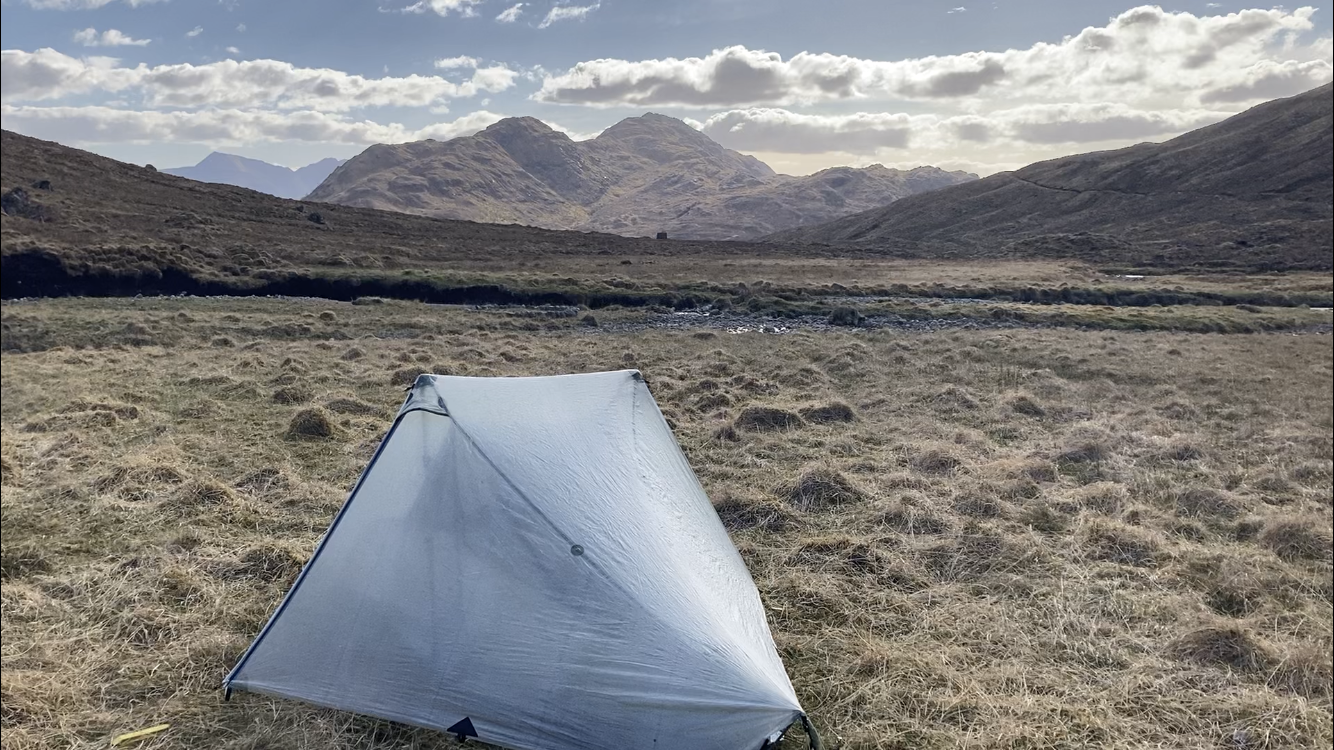The Notch was my first ultralight tent, and I adore it so much I have named it.
Here I am talking about the 2020 version.
Specs
The highlights from the website:
- Stated packed weight (solid inner version, stakes excluded): 572g (1lb 4.1oz)
- On my scales: 580g (1lb 4.4oz)
- When wet: No increase, dyneema does not absorb water
- 1 person
- 3+ season
- Non free-standing
- Trekking poles required
- Packed Size: 12 x 43 cm (4.7 x 17 inches)
- Floor Dimensions: 20 – 34 in / 51 – 86 cm x 84 in / 213 cm
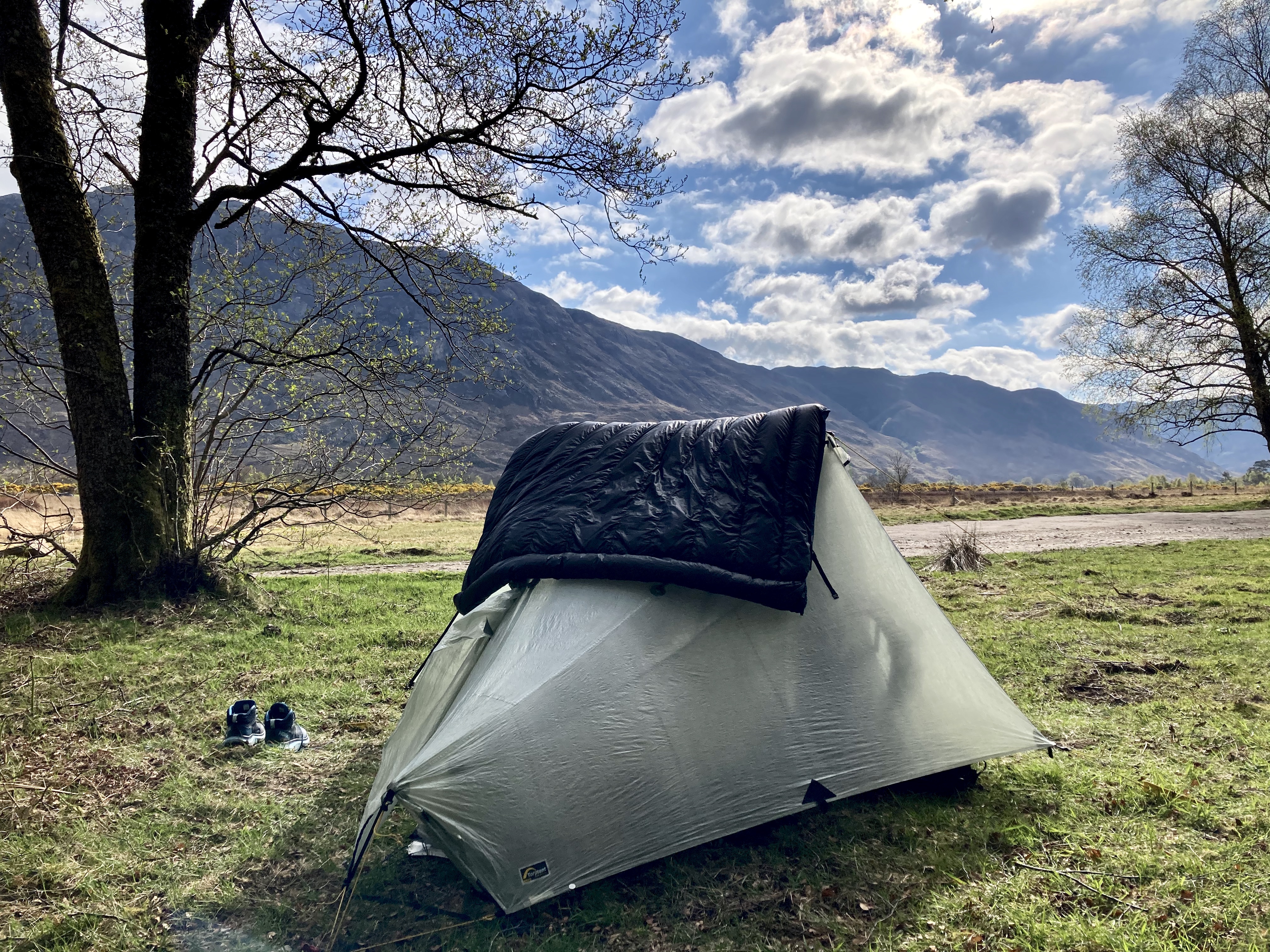
Hot take
- Ultralight? Yes.
- Set up time? 5 mins.
- Set up ease? Straightforward once you get the hang of it.
- Can be set up/taken down fly first? Yes.
- Ventilation/Condensation? Very good.
- Packability? Somewhat bulky. I generally stuff it vertically in my 40 and 50L packs.
- Easy to get back into stuff-sack? Yes.
- Wind performance? Very good.
- Rain performance? Excellent.
- Snow performance? Not tested. Likely fairly good.
- Fits wide pads? Yes, but only mummy-shaped.
- Can sit up/live comfortably? Yes.
- Vestibules? 2. Good size.
- Would recommend? Yes, 100%.
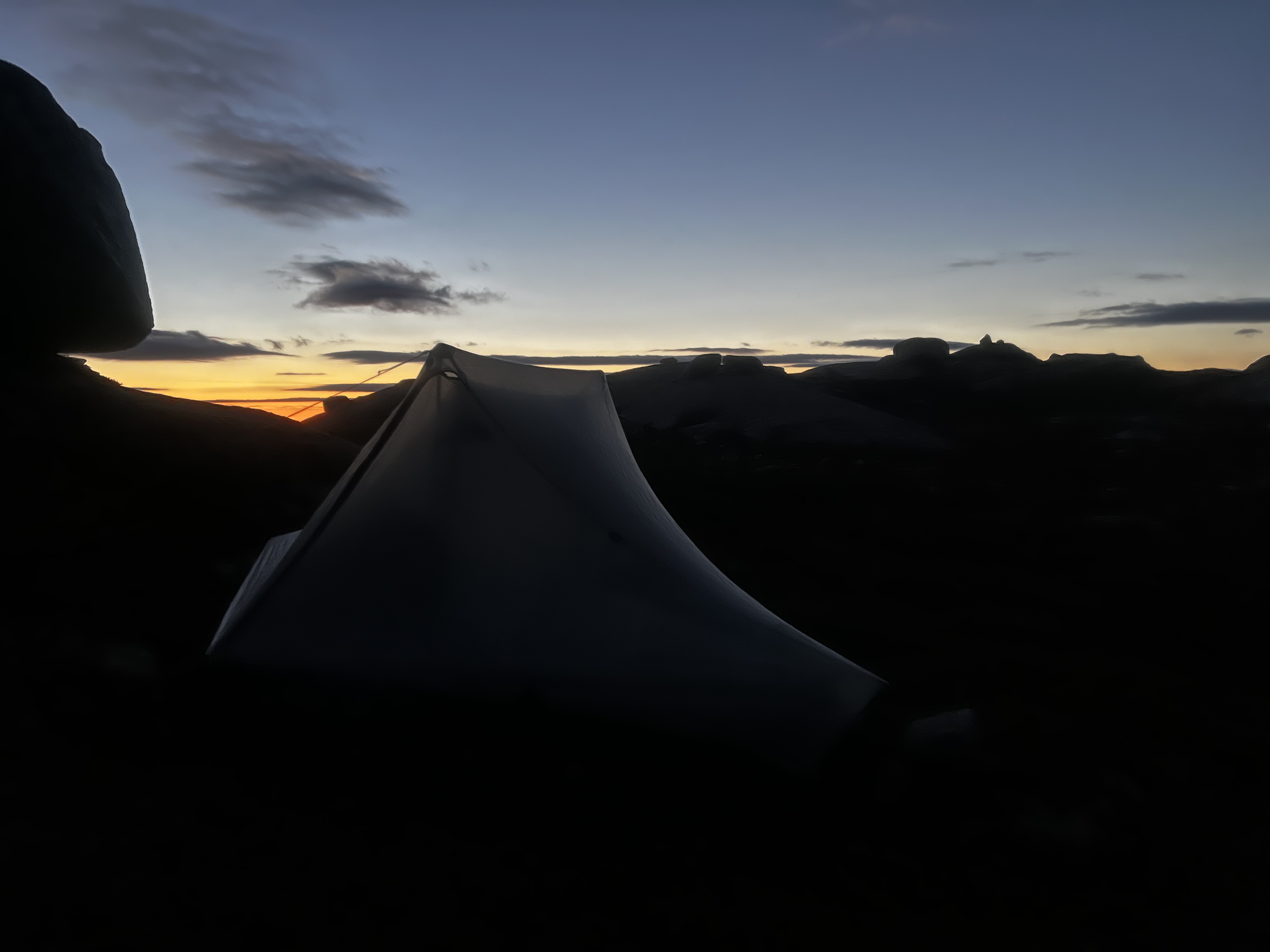
Tell me more…
What I like
- The stiffness of dyneema as well as the end struts makes it so easy (for me) to manage and roll up back into the stuff-sack in any weather. In high wind or rain, I have never had any difficulty getting it all put away neat and tidy. With some Silnylon ultralight tents, I find the material so slippery that it is impossible to pack away neatly, meaning you end up stuffing it in and, if wet, getting the inner soaked. Which leads me to…
- It is so easy to keep the inner dry with this tent. I have put it up and packed it away wet/damp so many days in a row, and the inner has always been perfectly dry. I love not having to worry about it.
- The double vestibules are so roomy. For a 1p tent this is great and makes it feel larger and more livable than it would otherwise. I like to use one side for “stuff I won’t need at night” (shoes, gaiters, etc) and the other for my backpack containing “stuff I may need”.
- The headroom throughout the inner is fantastic. The pitch-lock struts at either end make such a difference; there is no fabric draping across my face when I sleep and there is very little contact with the footbox of my quilt at the other end. In the centre I can easily sit up, change clothes and even kneel up to compress things into my pack. I am 5’8” by the way.
- The weight.
- The weather performance. I never doubt its waterproofness, and I never worry
about wind. I usually always stake out with rocks ready for a storm, because
I refuse to get out of bed in the middle of the night. The Notch is cleverly
designed so that all stakes tension along at least 2 seams. This provides much greater
strength and structure than any mid-panel guy points. Once the apex guys are out
then the rigidity is very reassuring. Below is a pic from when I pitched in a hurricane
which passed over the Cairngorms in October 2020. (I was sheltering in the bothy
while the storm passed. As “bomber” as we like to declare tents, I am not idiot enough
to think a sheet of plastic is actually bomb-proof.) You can see the fly bowing
from the force of the wind, but the poles held firm for the 4 hours I left it out.
I felt satisfied that if I had no choice but to camp in such conditions, the tent
would help me survive, even if it did not let me sleep.

- The ease of pitching. Once you are comfortable with the setup, it really does take moments.
- The condensation performance for this tent is one of the best I have seen. There have only been 2 nights out of 50 where my quilt has gotten damp. One was when, expecting a storm to blow in per the forcast, I pitched very defensively: on the leeward side of a hill in a clearing between a dense grove of trees and bushes. The opposite weather happened, and the wind dropped to nothing and it drizzled all night. To stop the inner getting completely soaked I had to open all available vents and unzipped the doors as much as possible. I dread to think what it would have been like in any other tent! The second time was a recent winter camp during which the internal temp got to -7C, and some ice formed on the top of my quilt. This is unavoidable below freezing and no tent would have managed better; if I had wanted to protect my down I could have brought a bivvy or a synthetic top layer.
- The smaller footprint makes this great for pitching in small areas. While its non-freestanding nature means you always need
to allow some room for tensioning, I have been able to squeeze this into some narrow
spaces which I would not have otherwise condsidered. Below you can see how I managed
to fit on one of the few tiny strips of dried up bog in a very rocky area, using
stacked rocks for 4 out of 6 stakes.
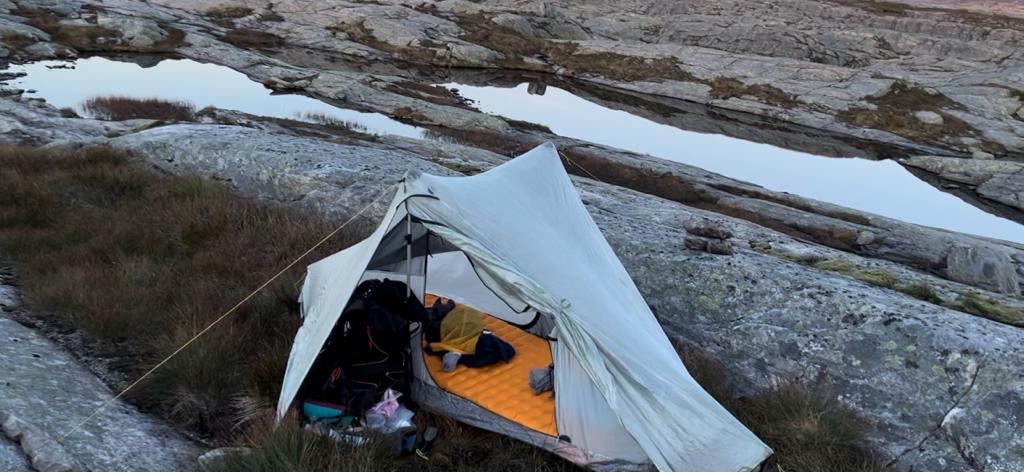
- The doors open in opposite directions from each other. This is fantastic because you don’t need to care about which end your head is going to be when you pitch. (This matters as you really don’t want to fall asleep with your head at a lower elevation than your feet!) You simply put it up with one end to the wind, and decide once you get in. If the wind turns around during the night, you can simply switch to using the other door to get in/out.
What I don’t
- You can’t fit all types of wide pad, despite what it says on the Tarptent
website. It may feel a bit tantrumy to say ‘it fits some wide pads but not the
exact one I want’, but aargghh for that extra inch! In the picture on the website,
and in the picture I include below, you can see that a regular wide Nemo Tensor (25”x72”)
does technically ‘fit’… but it is tight. You can see that it is pressed
against bathtub wall just under the seams, and while you may think “ah well
that’s not too bad, I can live with that”, it will only stay in that position
if you don’t touch anything. The situation changes once you get in, and what I have
found is that as soon as I get in and start moving around, one or more corners
will pop above the seam-line and push into the inner wall material. Sometimes I have woken up
and found these corners pressing into the fly wall, or even out from under the fly itself.
This especially happens if I can not find a perfectly flat pitch, which as we
all know is rare af.
The issue is that while the central width of the Notch inner is 34” (more than
enough room for a wide pad), the end widths are just 20”. So 5 inches too narrow.
In the end I got a Sea-to-Summit Women’s Ether Light XT Insulated
which is very comfortable and fits perfectly… but I was annoyed that I had to buy
a whole other mat when I had intended to stick with the Tensor until it gave out.
For me a wide pad is non-negotiable, since my SacroIliac Joint Dysfunction means that,
if I can’t sleep with my knees tucked up, the pressure on my spine will be so bad
that walking the next day would be impossible.
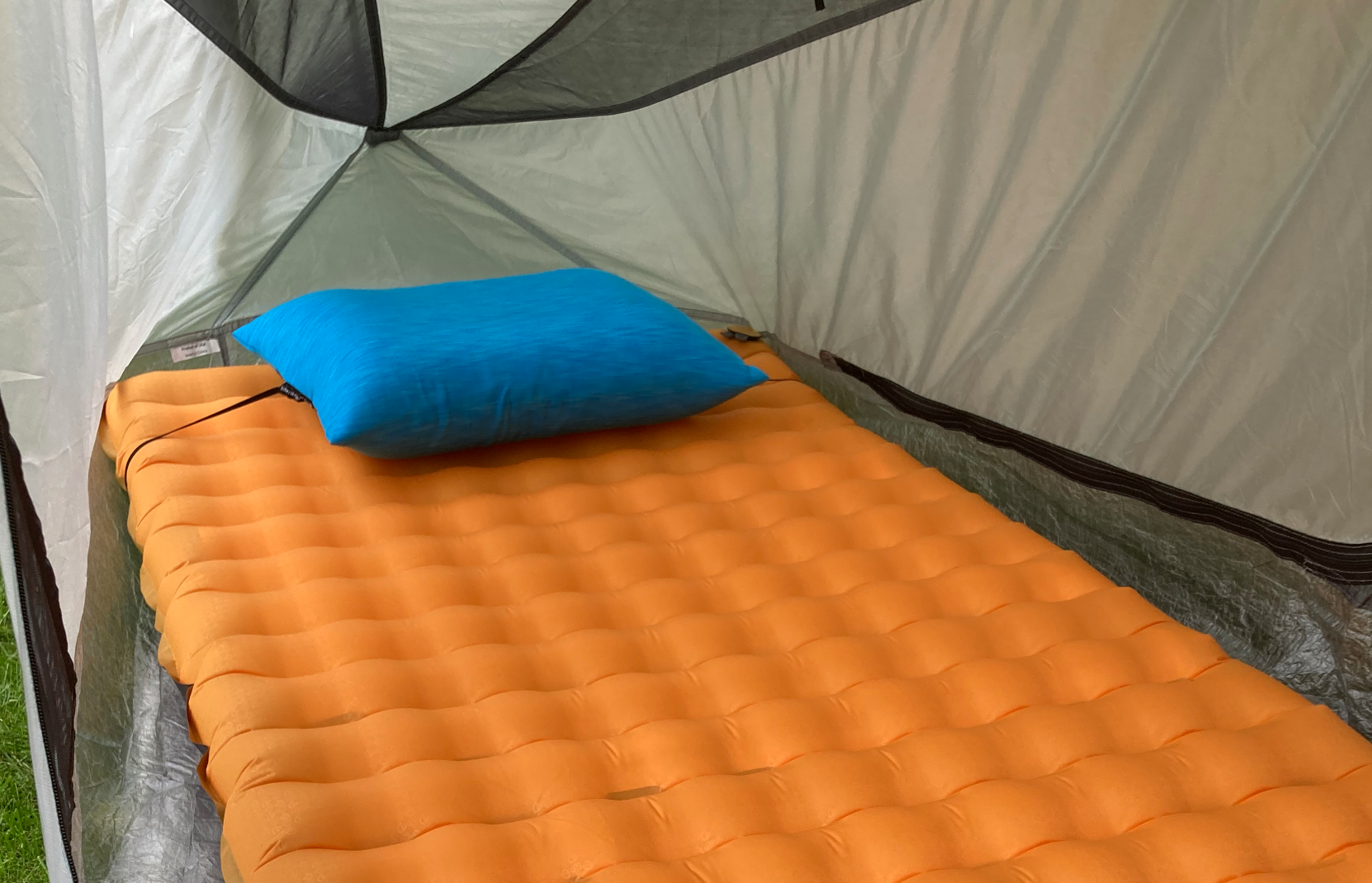
- The inner can sometimes poke outside from under the fly if you are not careful with your pitching. I mentioned this above, and having a rectangular wide pad can make this more likely. Sometimes you have no choice but to pitch on a less-than-ideal slope, and because the straps which attach the inner to the outer cannot be adjusted, it will slide to the lower end or corner. The straps which are meant to sit under your pole handles do not stop this happening. I am thinking about modifying those attachment points to be more ajustable, so that if (when) I have to pitch on a slope I can pull it more towards the upper end.
- The pockets are a bit pointless (in size and form), but I don’t carry much stuff so don’t really put anything in them.
- The pack-size is a little bulky due to the struts. Dyneema does not compress as well as Sil-nylon/poly anyway, but the struts mean that the packed tent is always >40cm. It therefore cannot fit horizontally in a pack. The struts are removable, but, a) this is fiddly to do, especially with cold-fingers, b) I would worry about transporting these ultra-fragile, ultra-losable carbon sticks without the buffer of the tent wrapped around them, and c) having them in does make it so easy to roll the tent up neatly. On balance this is a fine trade-off for me, and I am happy with my method of packing away vertically inside my backpack.
- The thinness of the material may be a problem for some people, especially those
who like a lie-in. This is a known trade-off for dyneema tent enthusiasts, but if
you are used to a dark green silnylon, it may seem very bright in there.
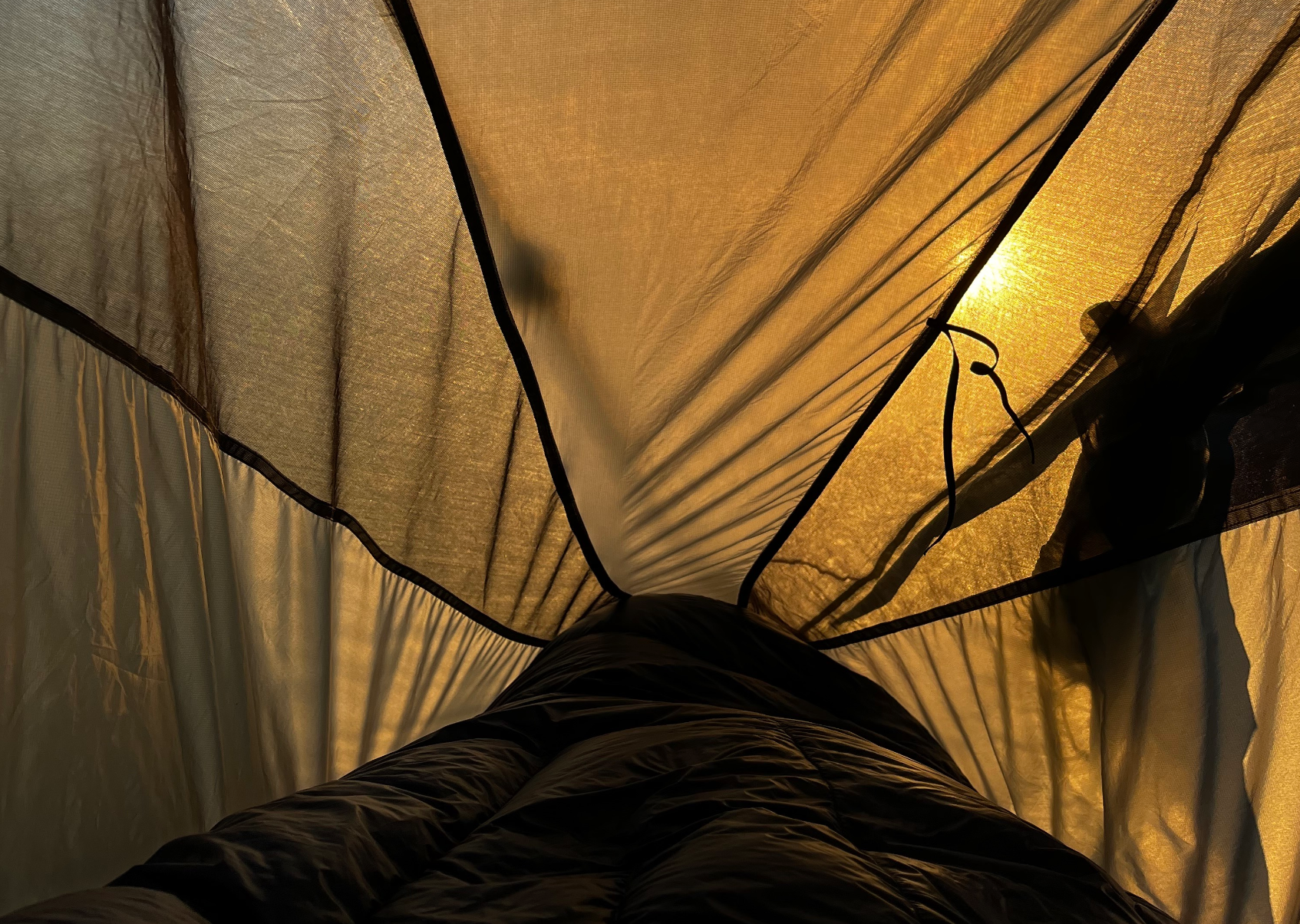
Tips and Mods
Packing
As I said above, the packed size is a little bulky. You have 3 choices here: strap to the top/bottom of your backpack, shove in a side pocket, stuff vertically inside the backpack.
In the past I have kept the Notch one of the side pockets of my AtomPacks Mo 50L, but don’t love the idea of having my very expensive tent on the outside where anything can catch on it. I have since shrunk my gearlist, so now I pack my tent inside. I do this even after switching to the smaller AtomPacks Atom+ 40L.
Obviously, I like the tent to be the last thing I pack up and put away. So this means I have to get it inside the pack vertically after everything else is already in there. I do this by tightening all the shock-cord straps on the right side of my pack, making that side narrower. I then put in the liner, stuff in my quilt and everything else, making sure it all stays mainly to the left and middle of the pack. Once that is all in, I roll away the tent, expand the cord/straps on the right, and slide the Notch into the gap. The last thing that goes in is my food bag and sit pad.
I got this idea from Paul Messner, but can’t remember the exact video of his that it was in. Thanks to this I can pack up in the rain, and still carry my tent inside my backpack.
Extra guy-outs
I got a couple of extra dyneema guy-outs along each bottom edge. The idea was to be able to pin the sides down if it got very windy, or to be able to hold a door half open if it was raining a lot. But I have not really used them much, so I would advise holding off on doing that until you see it as a problem you need to solve.
If you do need patches, and live in the UK, the guy behind WildSkyGear on eBay makes custom dyneema accessories and provides great customer service.
Footprint
I use a tyvek footprint with my Notch. I got a square of material from eBay (43g/sqm I think) and cut a diamond shape to fit the floor of the tent exactly. The seller included some tyvek tape so that I could attach some bungee or cord to the corners. I did this and it has come in handing to pin the footprint down when it is very windy. The weight of my footprint is 81g, which is fine for me. I have considered getting one of those plastic ones, but I don’t imagine they will last very long and it feels very wasteful. My tyvek has been all over the place and will keep going strong.
Fire!!!
This is a very embarrassing thing to admit, but I set fire to my Notch.
It was a rainy evening and it had been a long day, and I thought to myself:
“I’ll cook in the vestibule with the door closed, there is enough ventilation in this
tent”. That was true: the tent is very well ventilated. But even so, cooking with
your door closed is a dumb idea, because what happens if you knock the damn thing over?
THIS IS WHAT HAPPENS
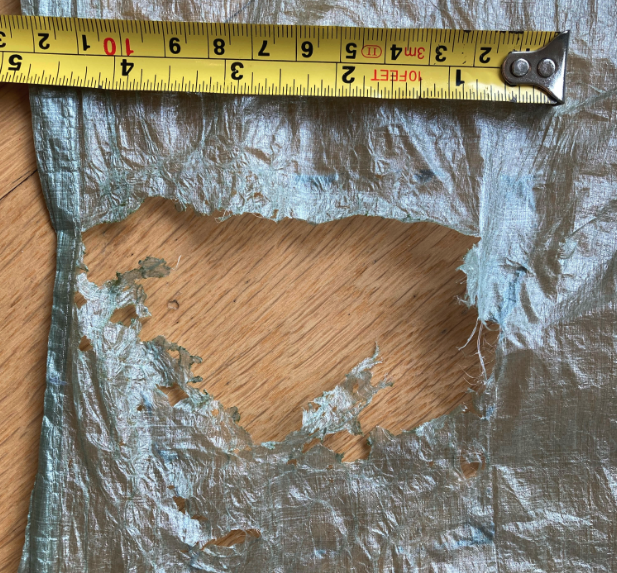
All was not lost. When I got back from my trip I contacted two people who do work with dyneema in the UK. One was the eBayer who sold me my tie-outs, the other was Paul Stokes at TreadLiteGear. I explained to both what had happened, and they each sent me custom dyneema tape patches. I used one set to repair the tent, and kept the other for when I inevitably do something stupid again.
Pole attachments
One thing I plan to do soon is alter the straps which go from the sides of the bathtub floor to underneath the pole handles. I often forget to put these under the handles until after I have adjusted and tensioned everything. So my idea is to modify the straps into short pieces of bungee cord mitten hooks on the end. Then I will be able to loop the bungee around the handle and clip back onto itself. For a tent which has poles inserted tip down, rather than tip up like the Notch, I would use those little claw pole clips (the sort that you get in free-standing tents to attach the inner to the poles) instead.
We’ll see how this mod goes!
Conclusion
The Notch is a fantastic 1 person tent, especially for those who are starting to think about lightening their packs but still want something sturdy for UK conditions. Tarptent are known for clever geometric designs which perform very well in wind, and the Notch lives up to that reputation.
The solid inner is perfect for this soggy isle and the livable space makes it such a pleasant place to be for long hours trapped by the rain.
Occasionally Tarptent sell “blem” models (tents with cosmetic blemishes in the dyneema) for slightly cheaper. Mine is one of these, and honestly I forgot about it until I wrote this. The tent performs perfectly and is a stunner.
